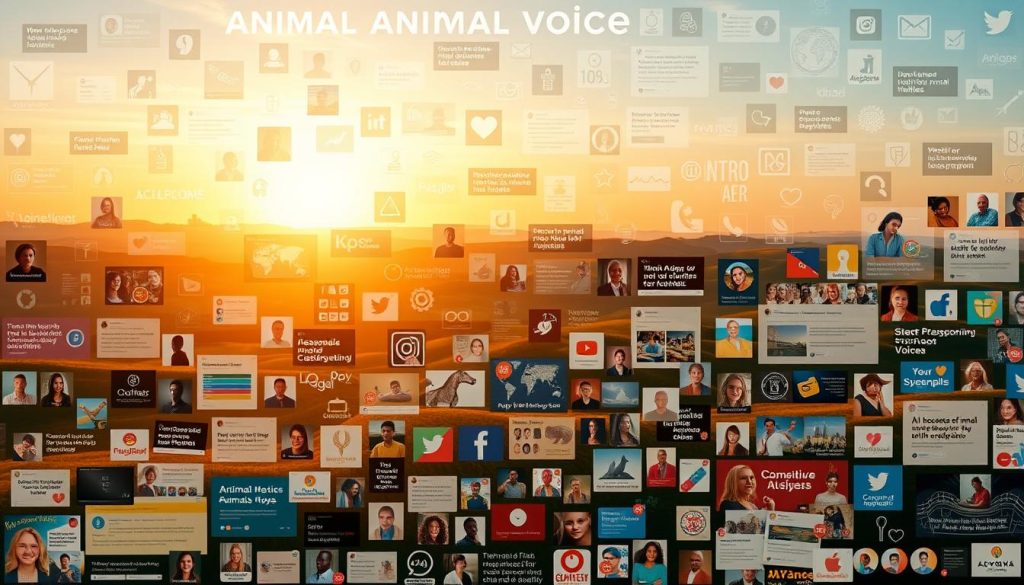Cats and dogs have long been cherished as beloved household pets, providing companionship, love, and joy to millions of families worldwide. Yet, these furry friends have evolved to become much more than just loyal companions. They now serve as powerful advocates for animal welfare and voices for change in the global fight for animal rights and awareness.
As pet ownership has grown, so too has the understanding of the immense responsibilities that come with caring for an animal. Pet owners are becoming increasingly aware of the importance of providing not only food, shelter, and medical care but also mental stimulation, socialization, and love. This heightened sense of responsibility has led to a stronger human-animal bond and a deeper appreciation for the unique personalities and needs of each individual pet.
With this enhanced understanding comes a greater desire to advocate for the welfare of all animals, not just those in our homes. Cats and dogs have become the face of animal advocacy, inspiring their owners to get involved in local, national, and even international efforts to promote animal rights, fight against cruelty, and raise awareness about the plight of animals in need.
Understanding Animal Awareness and Advocacy
Animal awareness is the recognition and appreciation of the sentience, intelligence, and emotional capacity of animals. It involves acknowledging that animals are capable of experiencing a range of emotions, including joy, fear, and pain, and that they have unique personalities and needs. Animal awareness is the foundation for promoting animal welfare and preventing animal cruelty.
Advocacy plays a crucial role in advancing animal welfare. By raising awareness about the issues affecting animals and educating the public about proper pet care, advocates help create a more compassionate society. They work tirelessly to expose cases of animal cruelty, push for stronger animal protection laws, and promote adoption and responsible pet ownership.
What is Animal Awareness?
Animal awareness involves recognizing that animals are sentient beings with their own unique personalities, emotions, and needs. It means understanding that they are capable of experiencing joy, fear, pain, and a range of other emotions. Animal awareness also includes acknowledging the intelligence and cognitive abilities of animals, as well as their capacity to form strong bonds with humans and other animals.
By promoting animal awareness, we can foster a more compassionate and empathetic society that values the well-being of all creatures. This awareness helps us make more informed decisions about how we treat animals, whether they are our beloved pets or the countless animals in the wild, on farms, or in laboratories.
Importance of Advocacy in Animal Welfare
Advocacy is the driving force behind positive change in the animal welfare movement. Animal advocates work tirelessly to raise awareness about the issues affecting animals, educate the public about proper pet care, and push for stronger animal protection laws. They expose cases of animal cruelty, fight against inhumane practices in industries that exploit animals, and promote adoption and responsible pet ownership.
Effective animal welfare advocacy relies on a combination of education, legislation, and community engagement. By educating people about the needs of animals and the importance of treating them with kindness and respect, advocates help create a more informed and compassionate society. They also work to pass and enforce laws that protect animals from abuse and neglect, ensuring that those who harm animals are held accountable for their actions.
Community engagement is another key aspect of animal welfare advocacy. By organizing events, fundraisers, and volunteer opportunities, advocates bring people together to support the cause and make a difference in the lives of animals. These efforts not only help animals in need but also foster a sense of community and shared responsibility for the well-being of all creatures.
The Historical Bond Between Humans and Pets
The human-animal bond has a rich and fascinating history that spans thousands of years. Cats and dogs, in particular, have played significant roles in human households and cultures around the world. Their presence has not only provided companionship but also shaped our understanding of the emotional connections we share with animals.
A Brief History of Cats and Dogs in Households
The domestication of cats and dogs dates back to ancient times. Cats were first domesticated in the Near East around 7500 BCE, likely due to their skill in hunting rodents that threatened grain stores. Dogs, on the other hand, were domesticated even earlier, with evidence suggesting they lived alongside humans as early as 15,000 years ago. Over time, both cats and dogs became beloved household pets, offering companionship, protection, and assistance in various tasks.

How Pets Have Influenced Human Culture
The influence of cats and dogs on human culture is undeniable. They have been depicted in art, literature, and mythology for centuries, often symbolizing loyalty, grace, and other admirable qualities. In many societies, pets have been viewed as family members, receiving the same love and care as their human counterparts. This deep emotional connection has led to the rise of pet adoption and the recognition of the importance of emotional support animals in recent years.
The impact of pets on human culture can be seen in various aspects of our lives, from the way we design our homes to the products we buy. Here are a few examples:
| Cultural Aspect | Pet Influence |
|---|---|
| Home Design | Pet-friendly furniture, dedicated pet spaces |
| Entertainment | Movies, TV shows, and books featuring pets |
| Language | Pet-related idioms and expressions |
| Social Interaction | Pet-oriented events, such as dog parks and cat cafes |
As our understanding of the human-animal bond continues to grow, it’s clear that pets will remain an integral part of our lives and culture. By embracing pet adoption and recognizing the value of emotional support animals, we can further strengthen the connection between humans and their beloved companion animals.
The Emotional Impact of Pets on Their Owners
The bond between pets and their owners goes far beyond simple companionship. Studies have shown that the human-animal bond can have a profound impact on an individual’s emotional well-being. Pets, especially cats and dogs, have the ability to provide unconditional love, comfort, and support to their owners, making them invaluable members of the family.
The Mental Health Benefits of Pet Ownership
Owning a pet has been linked to numerous mental health benefits. Interacting with a pet can help reduce stress, anxiety, and feelings of loneliness. The presence of a furry companion can also provide a sense of purpose and structure to daily life, which can be particularly beneficial for those struggling with depression or other mental health challenges.
Research has also shown that pet ownership can help improve self-esteem and social connections. Walking a dog, for example, can lead to increased social interaction and a sense of community. This can be especially important for older adults or those who live alone.

Healing Through Companion Animals
The therapeutic benefits of companion animals have been recognized in a variety of settings. Emotional support animals, in particular, have gained increased attention for their ability to provide comfort and support to individuals with mental health conditions or emotional disabilities.
Therapy animals, such as dogs and cats, are also commonly used in hospitals, nursing homes, and schools to provide comfort and reduce stress. The simple act of petting an animal has been shown to lower blood pressure and increase feelings of relaxation.
To ensure that pets can provide these emotional benefits, it is crucial for owners to prioritize proper pet care education. Understanding the physical and emotional needs of companion animals is essential for maintaining a healthy and balanced relationship that benefits both the pet and the owner.
Social Media: Amplifying Voices for Animals
Social media has become a powerful tool for animal advocacy, allowing individuals and organizations to raise awareness about animal welfare issues and promote positive change. With the ability to reach a global audience, social platforms have given a voice to the voiceless and have helped to bring attention to the plight of animals in need.

One of the most notable trends in recent years has been the rise of pet influencers on social media. These furry celebrities have captured the hearts of millions, using their charm and cuteness to promote animal welfare causes. From advocating for adoption to raising funds for animal shelters, pet influencers have become a force for good in the world of animal advocacy.
The Rise of Pet Influencers
Pet influencers have taken social media by storm, with some of the most popular accounts boasting millions of followers. These four-legged ambassadors use their platforms to promote animal welfare causes, such as adopting from shelters, spaying and neutering, and supporting animal rescue organizations. Some notable pet influencers include:
- Nala Cat (@nala_cat) – With over 4 million followers on Instagram, Nala uses her influence to promote cat adoption and raise funds for animal shelters.
- Doug the Pug (@itsdougthepug) – This adorable pug has over 3 million followers on Instagram and uses his platform to support various animal welfare causes.
- Juniper the Fox (@juniperfoxx) – As an ambassador for exotic pets, Juniper raises awareness about the challenges of caring for wild animals in domestic settings.
Campaigns Making a Difference on Social Platforms
In addition to pet influencers, social media has also been a driving force behind successful animal welfare campaigns. These initiatives have harnessed the power of social platforms to raise awareness, gather support, and effect real change. Some notable campaigns include:
- The #AdoptDontShop movement – This campaign encourages people to adopt pets from shelters rather than buying from breeders or pet stores, helping to reduce the number of animals in need of homes.
- The #SpayNeuter initiative – By promoting the importance of spaying and neutering pets, this campaign aims to control the stray animal population and reduce the number of unwanted litters.
- The #BetterWithPets program – This Purina-sponsored campaign highlights the benefits of pet ownership and encourages people to adopt pets from shelters.
Through the power of social media, these campaigns have reached millions of people, inspiring them to take action and make a difference in the lives of animals. As social platforms continue to evolve, they will undoubtedly play an increasingly important role in animal advocacy and the fight for animal welfare.
Cats and Dogs in Advocacy Roles
Beyond being cherished household companions, cats and dogs are increasingly taking on vital roles as advocates for animal welfare and emotional support. These furry friends are proving their immense value in various settings, from therapy sessions to service work, making a profound impact on the lives of both humans and animals alike.
Therapy Animals in Practice
Therapy animals, particularly cats and dogs, are becoming more common in hospitals, nursing homes, schools, and mental health facilities. Their presence offers comfort, reduces stress, and promotes emotional well-being. Research has shown that interacting with therapy animals can lower blood pressure, decrease feelings of loneliness, and encourage communication.

The process of becoming a certified therapy animal involves rigorous training and evaluation to ensure they possess the right temperament and skills. Once certified, these animals participate in structured visits, bringing joy and support to those in need. The positive effects of therapy animals highlight the importance of the human-animal bond and its role in promoting animal welfare.
Service Dogs and Their Impact
Service dogs are specially trained to assist individuals with disabilities, providing them with greater independence and improved quality of life. These intelligent and dedicated animals can perform a wide range of tasks, such as guiding the visually impaired, alerting those with hearing impairments, and assisting with mobility challenges.
| Type of Service Dog | Tasks Performed |
|---|---|
| Guide Dogs | Assist visually impaired individuals with navigation |
| Hearing Dogs | Alert individuals with hearing impairments to sounds |
| Mobility Assistance Dogs | Help individuals with physical disabilities perform tasks |
| Seizure Response Dogs | Detect and respond to seizures, ensuring the person’s safety |
The impact of service dogs extends beyond their practical assistance; they also offer emotional support and companionship. As a result, they have become powerful symbols of animal welfare and the incredible potential of pets to change lives. Through ongoing pet care education and public awareness, more people are recognizing the value of these skilled animals and the importance of supporting their training and placement.
The Role of Nonprofits in Animal Awareness
Nonprofit organizations play a vital role in raising awareness about animal welfare issues and advocating for the humane treatment of animals. These dedicated groups work tirelessly to educate the public, support animal shelters, and implement initiatives to control stray animal populations. Their efforts are crucial in creating a more compassionate society that values and respects all living creatures.
Key Organizations Raising Awareness
Several prominent nonprofit organizations are at the forefront of promoting animal awareness. The American Society for the Prevention of Cruelty to Animals (ASPCA) is a well-known organization that has been protecting animals since 1866. They provide resources, support, and advocacy to combat animal cruelty and neglect. The Humane Society of the United States (HSUS) is another leading organization that works to protect animals through legislation, education, and direct care.

Other notable organizations include Best Friends Animal Society, which operates the nation’s largest sanctuary for homeless animals, and Alley Cat Allies, which focuses on improving the lives of cats through advocacy, education, and community outreach. These organizations, along with countless others, are making a significant impact in raising awareness about animal welfare issues.
Fundraising Initiatives that Matter
Nonprofit organizations rely heavily on fundraising initiatives to support their animal welfare efforts. These initiatives not only provide the necessary resources to care for animals in need but also serve as powerful tools for raising awareness. Fundraising events such as charity walks, auctions, and galas bring together animal lovers and advocates, creating a platform for education and community engagement.
Online fundraising campaigns have also become increasingly popular, allowing organizations to reach a wider audience and generate support from around the world. Social media platforms have played a significant role in amplifying these campaigns, with viral challenges and hashtags spreading awareness about animal welfare causes. The success of these fundraising initiatives demonstrates the power of collective action in making a difference for animals.
Community Initiatives for Animal Welfare
Across communities, local initiatives are making a significant impact in promoting animal welfare and responsible pet ownership. Through a combination of education, outreach, and adoption programs, these grassroots efforts are helping to create a brighter future for cats, dogs, and other companion animals.

One of the most effective ways communities are making a difference is by organizing pet adoption events and partnering with local animal shelters. These events not only help to find loving homes for animals in need but also raise awareness about the importance of pet adoption as an alternative to purchasing from breeders or pet stores. By showcasing adoptable pets in a friendly, accessible setting, these programs are helping to break down barriers and encourage more people to consider welcoming a furry friend into their lives.
Education and Outreach Efforts
In addition to adoption initiatives, many communities are also investing in education and outreach programs to promote responsible pet care. These efforts often include:
- Workshops on basic pet care, including nutrition, grooming, and exercise
- Training classes to help owners better understand and communicate with their pets
- Resources on spaying/neutering, vaccinations, and other essential healthcare topics
- Outreach to schools and youth groups to teach the next generation about animal welfare
By empowering pet owners with the knowledge and skills they need to provide the best possible care for their companions, these education initiatives are helping to create happier, healthier lives for both animals and their human families. As more communities embrace these efforts, the positive impact on animal welfare will only continue to grow, one wagging tail at a time.
Celebrating Pets as Advocates
Pets have long been cherished companions, but their impact extends far beyond the walls of our homes. Through their unique bonds with humans, cats and dogs have become powerful advocates for animal rights and welfare. These furry friends not only provide emotional support and enrich our lives, but they also inspire us to take action and raise awareness about the importance of animal advocacy.
Famous Cats and Dogs in Animal Rights
Throughout history, certain cats and dogs have left an indelible mark on the animal rights movement. One such example is Tara, the heroic cat who gained international attention in 2014 when she bravely defended a young boy from a vicious dog attack. Tara’s actions showcased the deep human-animal bond and highlighted the protective nature of our feline friends.
Another notable advocate is Bretagne, the last surviving search and rescue dog from the 9/11 World Trade Center attacks. Bretagne’s tireless efforts and loyal service not only provided comfort to those affected by the tragedy but also raised awareness about the crucial role of working dogs in emergency situations. Her legacy continues to inspire animal lovers and advocates worldwide.
Personal Stories of Advocacy
Beyond famous cats and dogs, countless pet owners have become passionate advocates for animal rights. Take Sarah, a young woman who adopted an emotional support animal named Max. Through her experience with Max, Sarah discovered the transformative power of the human-animal bond and became an active volunteer at her local animal shelter. She now dedicates her time to promoting animal adoption and raising funds for animal welfare organizations.
Another inspiring story is that of John, a retired veteran who found solace and purpose through his service dog, Luna. Recognizing the profound impact Luna had on his life, John started a non-profit organization that connects veterans with trained service animals. By sharing his personal journey and advocating for the benefits of animal companionship, John has helped countless veterans find healing and support.
These personal stories demonstrate how the love and bond we share with our pets can ignite a passion for animal advocacy. By celebrating the role of cats and dogs as advocates and sharing our own experiences, we can inspire others to join the fight for animal rights and create a more compassionate world for all creatures.
Future Trends in Animal Awareness
As we look to the future, exciting developments are on the horizon for animal awareness and advocacy. Technology is playing an increasingly important role in transforming how we promote animal welfare and prevent cruelty. From social media campaigns that reach millions to innovative apps that connect animal lovers, digital tools are empowering activists like never before.
Artificial intelligence is also being leveraged to analyze data and identify patterns of animal abuse, enabling more targeted and effective interventions. Virtual reality experiences are fostering empathy by immersing people in the lives of animals, from factory farms to wildlife habitats. As these technologies advance, they hold immense potential to revolutionize the fight against animal cruelty.
How Technology is Changing the Landscape
In addition to driving awareness, technology is directly impacting animal welfare in numerous ways. Drones equipped with thermal imaging cameras are being used to locate and rescue animals in disaster zones. GPS tracking devices are helping to monitor and protect endangered species. 3D printing is enabling the creation of customized prosthetics for injured animals. As these solutions become more accessible and affordable, they are poised to make a profound difference in the lives of countless creatures.
Predictions for Pets’ Roles in Social Justice
Looking ahead, it’s clear that pets will continue to play a vital role in social justice movements. From therapy dogs comforting marginalized communities to cats starring in campaigns against discrimination, our furry friends have the power to touch hearts and minds. As animal ambassadors, they remind us of our shared humanity and the importance of compassion for all beings. By harnessing this power, we can build a more inclusive and empathetic world for both humans and animals alike. The future of animal awareness is bright, and with the help of our beloved pets, we can create a kinder, more just society for all.

